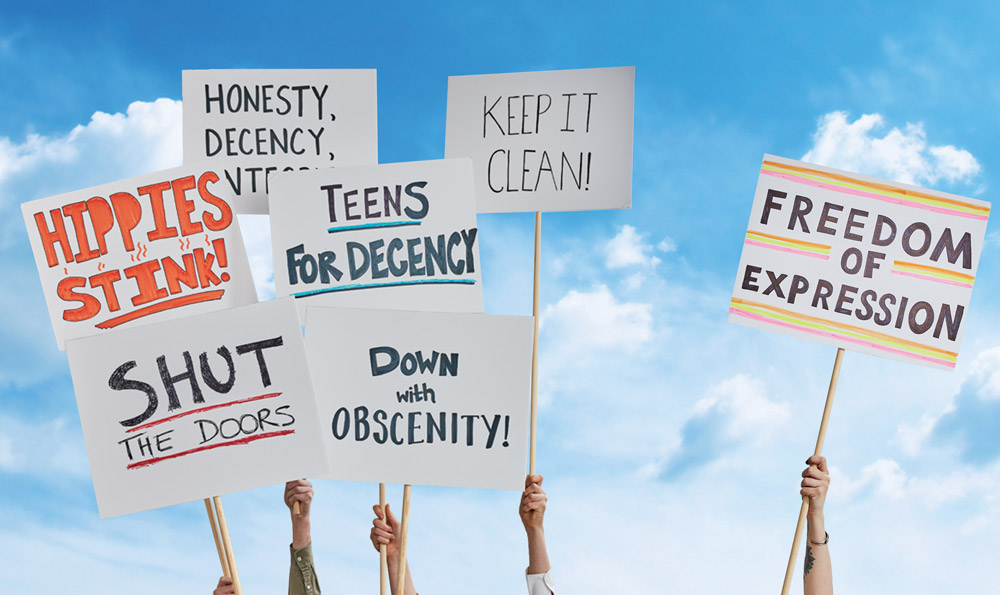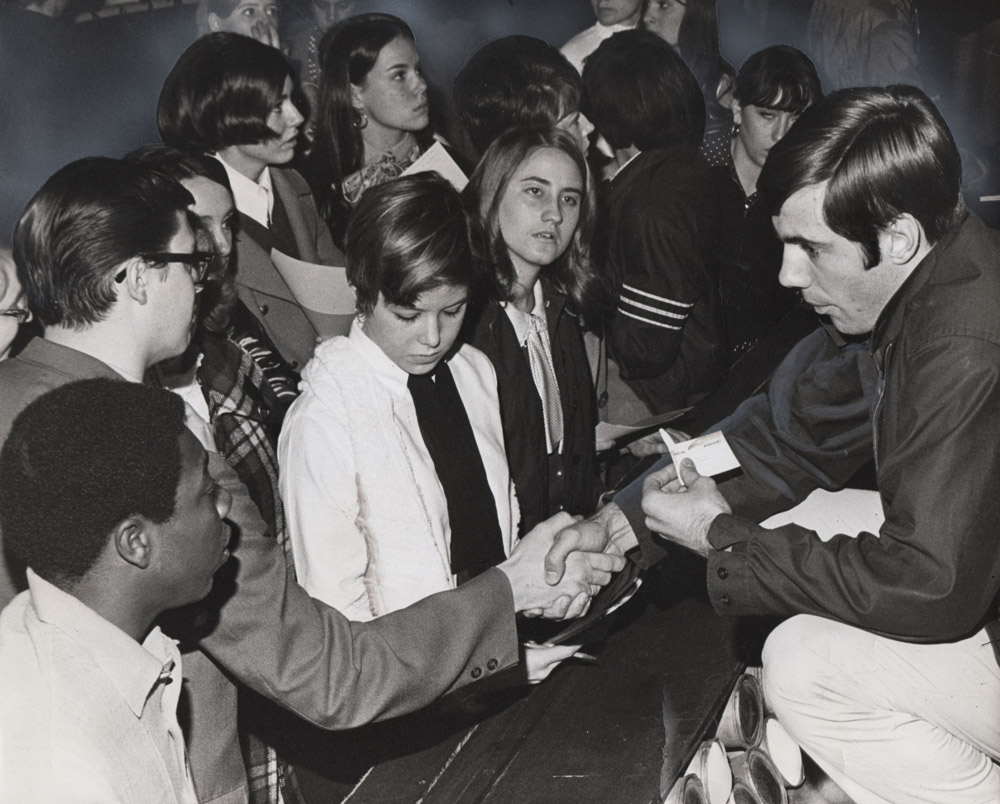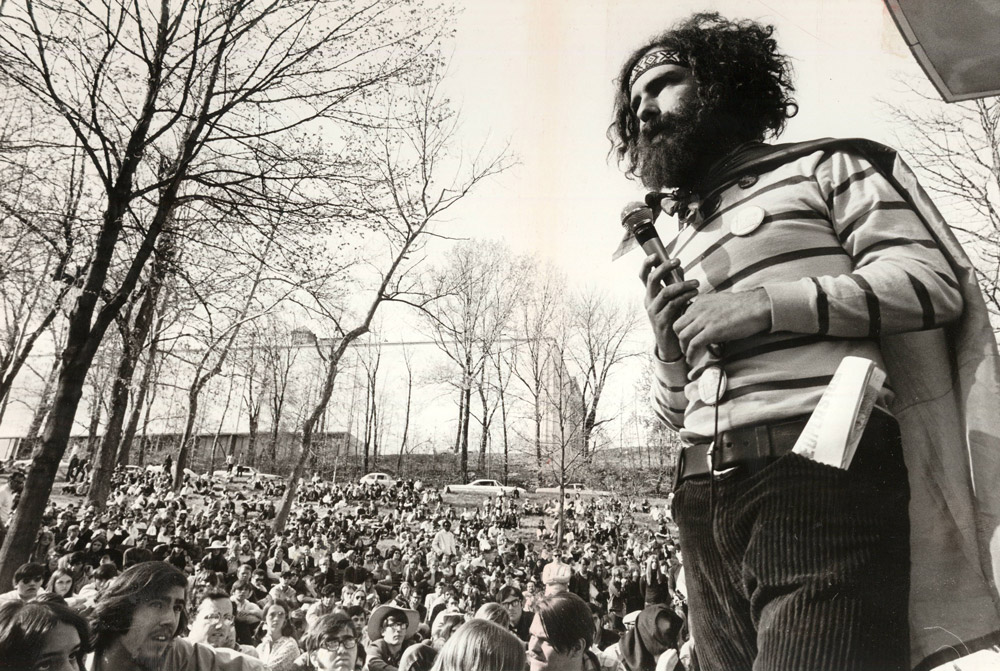This is the story of two penises, separated by 20 years and 1,000 miles. One was in Miami in 1969, and belonged to Jim Morrison of The Doors. The other was in Ohio in 1989, and caused the downfall of a popular politician. Between these two bookends—I feel more comfortable calling them bookends—rests the tale of two public events that happened in Cincinnati on the same day in 1969. Each, amusingly, was dedicated to condemning the other.

Photograph by Aaron M. Conway
Humor me for a moment and take this little test: Simply note whether you involuntarily smile upon seeing the name Congressman Donald “Buz” Lukens. Did you snort, even a little? OK, Boomer, you’ve betrayed your age. You can skip the following paragraph while our younger readers catch up.
Between 1966 and 1990, Buz Lukens represented areas north of Cincinnati (Hamilton, Middletown, Fairfield, West Chester, etc.) in Columbus and Washington, D.C. He was very popular. Unfortunately, he got convicted of having sex with an underage girl, which is a deal-breaker even today. Lukens arranged to meet with the girl’s mother at a McDonald’s to negotiate a cover-up, but sadly for him that conversation was videotaped. He went to jail twice—the second time for a Congressional bribe. The guy just had no decency.
Decency had once been what Buz Lukens was all about. He was among several politicians and celebrities who attended Cincinnati’s Teens for Decency rally, the first of our pair of opposed public events. About 10,000 people packed the Cincinnati Gardens, where Ohio’s and Kentucky’s governors and Cincinnati’s mayor welcomed them. There was also an appearance by America’s poster child for teenage innocence, Dick Clark—the guy who’s still bringing us New Year’s Eve from the grave. Local TV host Bob Braun emceed. It was an afternoon of inspirational speeches, patriotic demonstrations, and lots of what we today call virtue signaling.
Full credit for this event must go to Jim Morrison’s penis. The rock star had been arrested the previous month for exposing himself at a Doors concert in Miami, setting off explosions of national rage against filthy, longhaired hippies like him. Something had to be done to stop the vulgarity ruining America’s youth! Only two weeks after Morrison’s arrest, the first Teens for Decency rally was held in Miami’s Orange Bowl, near the scene of his crime.
Cincinnati was quick to join the decency bandwagon rolling across the nation. After all, along with Ivory Soap and Mr. Clean, overreacting to sexual controversy is our most cherished brand. First, an upcoming Doors concert here was abruptly canceled. Then, Cincinnati Enquirer columnist Frank Weikel proposed having our own Teens for Decency rally, which got immediate enthusiastic responses from every predictable direction. Braun invited Clark, who agreed to cover his own expenses. The American Legion supplied thousands of small American flags, Hennegan Printing donated 25,000 Teens for Decency car decals, and Cincinnati police officers volunteered their services. Additional support came from the Boy Scouts, Cincinnati Fire Department, Kiwanis, Shriners, and others. Tickets, which were free but required pre-order by phone or mail, were gone within a week.
This thing was going to be big. Early promotions suggested there would be music performances from James Brown, the Bee Gees, the Association, and more. Actual performances were from the Fun Explosions, the Mystics, the Heywoods, and less.

Photograph courtesy of The Cincinnati Enquirer/Ran Cochran
There’s nothing better for bringing people together than a common enemy. Students from area high schools and colleges flocked to volunteer for this massive orgy of wholesomeness. As teens began handling preparations themselves, the rally’s official student leader emerged, and he couldn’t have been more perfect: Fred Wymore, a clean-cut, 19-year-old, church-going, varsity-football-playing student council president from North College Hill. The UC freshman showed a knack for organization and leadership, and the media couldn’t praise him enough. Wymore later became a local and national Emmy-winning TV sportscaster, and then…well, we’ll get back to where his life eventually went.
Meanwhile, Newton’s Law about everything having an opposite reaction proved itself: Sales of Doors albums skyrocketed at local record stores, and another rally was hastily organized for the same day as Teens for Decency, purely for the purpose of mocking it. This one was instigated by Jerry Rubin, a Cincinnati native who’d become world-famous as a troublemaker. Anyone familiar with 1960s radicalism and protest knows about him. Alongside revolutionary buddies like Abbie Hoffman, Rubin helped invent ultra-extreme political theater. Imagine Michael Moore weighing half as much but being twice as disruptive—that was Jerry. Never one to pass up an opportunity for grandstanding, he decided to come home and headline an anti-rally at Eden Park.
On April 20, 1969, both events started at roughly the same time. The crowd at the Gardens, of course, had the vastly larger and louder turnout. No surprise, really. Teens for Decency had been proposed by an Enquirer writer, so his newspaper lavished it with front-page exposure and cheerleading, with other local media joining in. By every standard—except for the direction American culture continued to drift—the rally was a big success. The headline in the The Cincinnati Post, unmindful of how the country’s vocabulary was changing, called it a “gay event.” Allegiance was pledged, flags were waved, and a parade of political leaders sang the praises of morality. Braun read a telegram of support from President Richard Nixon, that exemplar of virtue. A “What Decency Means to Me” essay contest was promoted, with entrants to receive a book by J. Edgar Hoover, that exemplar of fashion. Wymore delivered a rousing speech, and Cincinnati Mayor Eugene Ruehlmann managed to get the biggest laugh. He claimed he’d entered the arena through a window, because “I don’t believe in doors.”

Photograph courtesy of The Cincinnati Enquirer/Mark Treitel
Over at Eden Park, Rubin had no bands or politicians, but his audience was just as enthusiastic. His rant called for total revolution against a society that had become like Pavlovian dogs. Under local law, he could easily have been arrested for his numerous F-bombs, but the cops had been instructed to get involved only if actual mayhem broke out. Rubin said he would run for Cincinnati Mayor (he didn’t), get Fidel Castro admitted to the Chicago Bar (didn’t), and get the voting age lowered to 14 (nope).
Back at the Gardens, as things were wrapping up, Wymore suddenly announced he was resigning. He had skipped countless classes at UC in order to work on the rally, and in desperately trying to drop a course before flunking it he got caught forging a professor’s signature and was expelled. Braun, though, exhorted the crowd to forgive Fred and keep him on. They did, via long applause.
When the day was over, both sides of the debate felt they’d won, secure in who they were, how they lived, and where their lives would lead. So who, from today’s perspective, turned out to be right? Don’t bother looking to either rally’s leader for the answer, because within 15 years, Jerry Rubin and Fred Wymore became the very people that each had warned their audiences about. Rubin ditched his hippie hair and bandana for short hair and a tailored suit, while Wymore ditched his short hair and tailored suit for hippie hair and a bandana. Rubin embraced the American Dream he’d rejected, becoming a Wall Street entrepreneur with a focused vision. And Wymore did the exact opposite, becoming a solo backpacker who traveled the world with no fixed agenda. He now lives on an island in the Gulf of Thailand. Rubin died in 1994.
Was any lasting difference made on April 20, 1969? Yes and no. The culture wars born in that decade are now middle-aged, and even grumpier. Some people have switched sides, but the shrillness of their certainty doesn’t seem to have diminished. “Teens for Decency” has been the name of a Canadian alt-rock band as well as a brief Cincinnati one, and The Simpsons creator Matt Groening used it as his political party’s name when he ran for high school class president. (He won.) Our local Teens for Decency organization did continue for a while, helping with initiatives like sending letters of encouragement to soldiers in Vietnam, fund-raising for a Lincoln Heights community center, and collecting donations to help create today’s Lighthouse Youth Services in Walnut Hills.
Maybe Cincinnati’s Decency rally sparked some teens into a lifelong habit of generosity. And maybe the young people at the opposing rally were sparked into a lifelong habit of skepticism. Both are commendable. Life lessons, good and bad, come from unexpected places. Might you have been part of Teens for Decency’s fund-raising effort to help starving refugees in Biafra? The chairman of that relief program probably was delighted to hear from any and all idealistic teenagers. His name was Congressman Donald “Buz” Lukens.





Facebook Comments